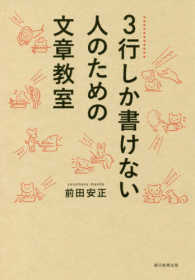- ホーム
- > 洋書
- > 英文書
- > History / World
Full Description
Winner of the 2014 Choice Outstanding Academic Title Award
In An Intellectual History of China, Professor Ge Zhaoguang presents a history of traditional Chinese knowledge, thought and belief to the late six century CE with a new approach offering a new perspective. It appropriates a wide range of source materials and emphasizes the necessity of understanding ideas and thought in their proper historical contexts. Its analytical narrative focuses on the dialectical interaction between historical background and intellectual thought. While discussing the complex dynamics of interaction among the intellectual thought of elite Chinese scholars, their historical conditions, their canonical texts and the "worlds of general knowledge, thought and belief," it also illuminates the significance of key issues such as the formation of the Chinese world order and its underlying value system, the origins of Chinese cultural identity and foreign influences.
Contents
Introduction: Chinese Intellectual History Writing
Brief Prologue: The History of Chinese Intellectual History Itself
Part One: The History of General Knowledge, Thought and Belief
Part Two: Between the History of Knowledge and the History of Thought
Part Three: the Foundational Presupposition of Chinese Thought: "Dao" or the "Way of Heaven"
Part Four: The Continuity of Intellectual History Emerges
Part Five: Historical Memory, Intellectual Resources and Reinterpretation
Part Six: Pictures Where There Are No Pictures: How to Deal With Empty Spaces in Intellectual History
Part Seven: Addition and Subtraction Methods in Intellectual History Research
Part Eight: What Can Be A Resource Material for Intellectual History?
Chapter One: Tracing the Origins of Chinese Intellectual History in the Three Dynasties (Ancient Times to ca. 6th Century BCE)
Brief Prologue: Remote Antiquity
Part One: Reconstructing the World of Ancient Thought: Traditional Written Documents, Modern Theory, and Archeological Discoveries
Part Two: The Shang Conceptual System as Recorded in the Oracle Bone Inscriptions
Part Three: Evolution of Thought as Recorded in the Written Documents and Bronze Inscriptions of the Western Zhou
Part Four: Chinese Script and Chinese Intellectual History
Part Five: Ceremonies, Symbols and A Numerological World Order as the Background of Later Intellectual History
Chapter Two: Hundred Schools of the Spring and Autumn and Warring States Periods, I (ca. 6th to 3rd Century BCE)
Brief Prologue: China's "Axial Age"
Part One: General Knowledge and Thought in the Spring and Autumn Period
Part Two: Continuation and Renewal of the Intellectual Tradition I: Ru or the Confucians
Part Three: Continuation and Renewal of the Intellectual Tradition II: Mo or the Moists
Part Four: Continuation and Renewal of the Intellectual Tradition III: Dao or the Daoists
Part Five: Elite Thought and General Knowledge: Implications of Mantic and Medical Arts in Intellectual History
Chapter Three: Hundred Schools of the Spring and Autumn and Warring States Periods, II (ca. 6th to 3rd Century BCE)
Part One: Warring States Hundred Schools Contend, I: Cosmic Space and Time
Part Two: Warring States Hundred Schools Contend, II: Social Order
Part Three: Warring States Hundred Schools Contend, III: Life of the Individual
Part Four: Language and Reality: the Warring States Period Disputations on Names
Chapter Four: Intellectual Convergence in the Qin and Han Dynasties, from ca. the 3rd Century BCE to ca. the Mid-2nd Century CE
Prologue: Coda to the "Hundred Schools of Thought Contending"
Part One: General Knowledge Background and Intellectual Achievement in the Qin and Han dynasties
Part Two: Toward A Synthesis of Knowledge and Philosophy: from the Luxuriant Dew of the Spring and Autumn Annals to the Huainanzi
Part Three: Establishment of A State Ideology: from the Luxuriant Dew of the Spring and Autumn Annals to the Discourses in the White Tiger Hall
Part Four: Classics and Apocrypha: the Consequences of Mutual Interaction between General Knowledge and Elite Thought
Chapter Five: Confucianism, Daoism and Buddhism from the End of the Eastern Han to the Early Tang Dynasty, I (ca. Mid-2nd to Mid-7th Centuries)
Prologue: Foreign Influence Enters China
Part One: Evolution of Autochthonous Chinese Thought and Learning from Han to Jin
Part Two: The Mysterious and Profound: A Turning Point of Intellectual History in the Third Century CE
Part Three: Purification of Daoist Teachings: the Religionization of Daoist Thought, Knowledge and Techniques
Chapter Six: Confucianism, Daoism and Buddhism from the Eastern Han to the Tang Dynasty II
Part One: the Transmission of Buddhism to China and Its Significance in Intellectual History, I
Part Two: the Transmission of Buddhism to China and Its Significance in Intellectual History, II
Part Three: Buddhist Conquest of China?
Part Four: Basic Outline of the Mainstream World of Knowledge and Thought in the Seventh Century
Bibliography







